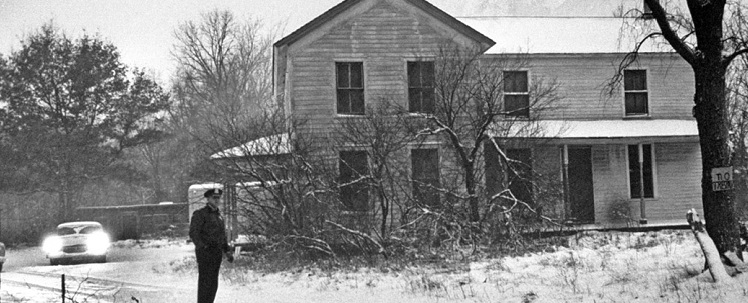The Attic: True Story of Ed Gein


Welcome to the Attic. Sit back, relax and take your masks off.
Case file: Ed Gein
*WARNING* This article is not for the faint of heart, and contains graphic descriptions of a crime scene, and the sick acts performed by an ever sicker man. Read at your own discretion.
We’re going to venture into real life horror for the first time in the Attic as we discuss the true story of Ed Gein. You may or may not have heard of him, but I guarantee you’ve heard of the films that were inspired by his…interests. In their own ways, Texas Chain Saw Massacre, Psycho, and Silence of the Lambs were all influenced by the real life story of this lunatic. I find stories of crime like this to be fascinating. There’s something intriguing about the criminally insane. It’s the same fascination we have with horror movies. It’s like driving by the scene of a car crash, you don’t want to see, yet you can’t look away. And this guy is like a 20-car pile-up on the 405 (people from Los Angeles know what I mean).
In 1957, America was a much calmer and safer place to be, especially in the midwest. Farm country and small towns were places that never saw crimes any grittier or more disturbing than your average shooting or domestic abuse. America was still processing Peyton Place from the confines of a book on their nightstand, and Elvis Presley’s shaking hips could not yet be shown on national TV without upsetting viewers. But in November of 1957 a news story would break that would truly shock the nation.

It was a cold morning in the small, quiet town of Plainfield, Wisconsin when authorities arrived at a farmhouse belonging to Ed Gein. Police were searching for Ed as a suspect in a recent burglary of a hardware store and the disappearance of the woman that ran it. What they found was one of the most horrific scenes imaginable, and one that would inspire some of the greatest horror films of all time.
They discovered everything from masks skinned from actual faces to entire bodysuits made from female bodies, complete with genitalia. They found the missing shopkeeper hanging upside down like a deer that had been caught and gutted, her head missing. The house itself was like a museum to his “trophies.” Skulls were made into bowls. chairs were upholstered with human skin. A table was propped up by shinbones. His refrigerator was full of human organs. The list goes on, but a few don’t need to be covered here. Although some could never be identified, it was determined at least 15 different women were taken there and dismembered, as well as used for his sick sexual fantasies.
Ed had stolen the bodies of almost all of these women from local gravesites. It was only near the end of his stint that he decided to take these parts from “fresher” female bodies, so as to achieve a more accurate transformation from male to female. He also transitioned from being a graverobber to murderer, now killing his last victims before he was caught. Included in the last of his victims was the missing shopkeeper, who also happened to be a local officer’s mother. It was her disappearance, coupled with the rumors that the reclusive Gein had oddly been spotted in town the day of her disappearance, led the officer to investigate the property.
Ed Gein was institutionalized in a state hospital, and remained there for about 20 years until he was moved to an institution where he lived out the rest of his days until cancer took his life in 1984.
Now let’s go over where his story exactly affected these films…
Psycho:
When you think of Psycho, the first thing you think of (aside from the shower scene) is Norman’s disturbing relationship with his mother. And the fact that he kept her body, rotting, in the house with him. He also had an obsession with women. This is what Robert Bloch took from Gein’s life when he wrote the novel that would become what is arguably Alfred Hitchcock’s finest.
Texas Chain Saw Massacre:
There are two things that inspired Tobe Hooper to pen this classic script. One was his rage and desire to grab a chainsaw in a very crowded store during the holiday season to “clear the way” out of there for himself. The other was Ed Gein’s practice of taking skin off of dead bodies and wearing them himself. This was used in a slightly different way, however. Gein did so in order to “transform” himself into a woman. He desired to be a woman, and even wore breasts he removed from cadavers. His use of bones and other remains to craft household items was another of Gein’s traits that were utilized by Leatherface.
Silence of the Lambs:
The character Buffalo Bill was also inspired by Gein’s practice of taking skin and female anatomy and wearing it to achieve a sexual change in his mind. Some feel this character is the most like Gein in terms of reasoning and sexual satisfaction from his deeds.
Horror films have terrified us all at some point in our lives. But when the line between real life and fiction are blurred, even destroyed, we truly know what it is to be frightened. We can’t change the channel, look away, or stop a DVD in real life. The most fundamental stories of horror are those created in our world, by us. Not on screen or on paper, but behind the doors of the most unassuming farmhouses. Maybe even that house next door in the beautiful suburbs. But it only makes sense that we would take inspiration from the sick minds of reality to create a scarefest. After all, it’s not all about life imitating art like some would claim. It’s actually much more common that art imitates life. So the next time you watch a horror film and tell yourself it’s only a movie, stop and think… is it?
Stay scared,
Dark Princess






![[PROTOTYPE]](http://www.enthusiacs.com/wp-content/uploads/2020/03/title-104x104.jpg)

Leave a Reply